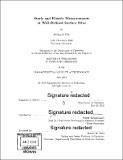Steric and kinetic measurements at well-defined surface sites
Author(s)
Chu, Sterling B. (Sterling Ben)
DownloadFull printable version (19.91Mb)
Other Contributors
Massachusetts Institute of Technology. Department of Chemistry.
Advisor
Yogesh Surendranath.
Terms of use
Metadata
Show full item recordAbstract
Extended sp² carbon materials display a wide variety of oxidic moieties on edge sites that can be selectively targeted for functionalization. Monarch 1300 (Cabot Corporation) is a carbon black consisting of 10 nm graphitic particles terminated by oxidic sites. This thesis aims to explore new avenues of research enabled by the covalent nature of linkages to graphitic nanocarbons. Covalent linkages to this surface allow for the decoupling of individual ligand properties from surface-solution ligand dynamics, a phenomenon on semiconductor and metal nanoparticles that inhibits the rational study of ligand effects on those materials. The covalent linkage to carbon is exploited in two different ways. When the ligand of interest is directly bound to carbon, its length and steric profile can be modulated without affecting the surface packing density. This enables isolation of ligand steric profile as a single contributing factor in the overall steric inhibition of the nanocatalyst. When the ligand of interest is bound to a conjugated organometallic complex, the complex is anchored, but the ligand is free to exchange. This allows for study of ligand exchange kinetics without the convoluting factors of surface migration or co-dissociation of surface metal atoms. The appendix contains two chapters with applications of carbon functionalization and a chapter on protection of 1,2-diamines. The first chapter demonstrates passivation of inner-sphere ET processes on glassy carbon via deposition of a fluorinated aryl film onto the electrode. At sufficiently thin deposition layers, outer-sphere ET rates are preserved. The second chapter describes condensation of crown ethers onto the electrode surface to serve as ionophores for aqueous metal ion detection. Binding of metal ions into the crown ether shifts the redox potential of the pyrazine linkage to the carbon electrode, and the concentration of metal ion can be quantified electrochemically. The third chapter explores various protection and deprotection strategies for 1,2-diamines, a moiety crucial for precursors to pyrazine-linked GCC materials.
Description
Thesis: Ph. D. in Inorganic Chemistry, Massachusetts Institute of Technology, Department of Chemistry, 2018. Cataloged from PDF version of thesis. Includes bibliographical references.
Date issued
2018Department
Massachusetts Institute of Technology. Department of ChemistryPublisher
Massachusetts Institute of Technology
Keywords
Chemistry.